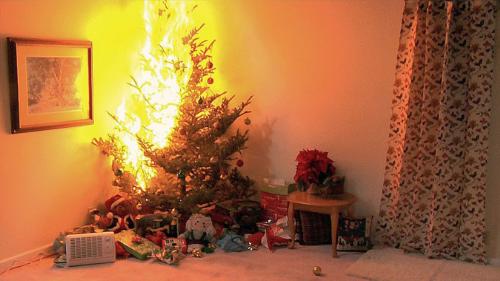We don’t want to be accused of being humbugs at this time of year but we do think it’s important to remind people of the fact that fire risks can increase over the Christmas period. So it makes sense to take a few moments to think about what you can do to manage those risks in the workplace. Some of the more obvious risks, like using candles, are less likely to apply in most workplaces than they are in the home. (That said, there will be some businesses, particularly those in the hospitality sector, that do tend to use them frequently over the festive period. The battery-powered ones give such an effective look, the ideal solution is to not use real ones at all!). For the majority of workplaces however, it’s most likely that one of the main fire risks comes from the increased electrical risks present.
One of the big issues is the extensive use of lights. Of course, they look great and it would be a pretty bleak Christmas if we didn’t have them brightening up workplaces (and homes). But putting lights up inevitably creates an additional fire hazard. A tree fire from a single faulty light can take hold and cause devastation within seconds. Real trees are particularly vulnerable. They can catch fire a lot quicker than the artificial (and fire retardant) ones. If you do decide to use a real one, be aware it’s important that it’s kept very well watered - real trees absorb up to a litre of water a day and the drier they are, the more flammable they become. And while some people advocate the use of spraying a real tree with hairspray to stop needles dropping, please don’t do it! Hairspray is extremely flammable.
So what other steps can you take to minimise the fire risk?
As an employer you’re obliged to make sure all electrical equipment with the potential to cause injury is maintained in a safe condition. That includes Christmas lights. Check over any lights you intend to put up before you use them. A quick initial visual check will help you spot any immediate signs of damage or loose wires but ideally get them PAT tested by an electrically competent person who has the correct equipment to do the tests and knowledge to interpret the results.
If any bulbs have blown, replace them before using the lights and only use the same kind of replacement bulbs as the original ones. If it turns out you do need to buy whole new sets of lights, a word of caution: check your Christmas tree lights conform to British Standards. It’s very easy for counterfeit electrical goods to slip through the net nowadays so always buy from reputable retailers. It’s preferable to buy LED lights as they use far less power than traditional lights, hence generating substantially less heat. And from an environmental perspective they are much better too – they use roughly 85% less electricity and last around 60 times longer. They also tend to be sturdier and less likely to break.
If possible, don’t use extension leads or adaptors. But if you have no choice, check the current rating to make sure you are not overloading it which could cause the plug in the wall socket to overheat. Never be tempted to plug an extension lead into another one. And be careful about where the leads are located to avoid creating a tripping hazard. If you’re planning on using any lights outdoors make sure they are specifically designed for external use. Make sure all outdoor lights are connected via an RCD protected socket too.
And finally – make sure you have a system in place where the lights get switched off and unplugged! Yes, it sounds obvious but it’s easy to presume ‘someone else’ will do it which can result in no one doing it.
If you have any queries relating to fire and security over the festive period, please do get in touch – and can we take this opportunity to wish you a very happy and safe Christmas!
